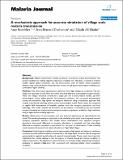| dc.contributor.author | Duchemin, Jean-Bernard | |
| dc.contributor.author | Bomblies, Arne | |
| dc.contributor.author | Eltahir, Elfatih A. B. | |
| dc.date.accessioned | 2010-03-11T18:24:51Z | |
| dc.date.available | 2010-03-11T18:24:51Z | |
| dc.date.issued | 2009-10 | |
| dc.date.submitted | 2009-05 | |
| dc.identifier.issn | 1475-2875 | |
| dc.identifier.uri | http://hdl.handle.net/1721.1/52514 | |
| dc.description.abstract | Background: Malaria transmission models commonly incorporate spatial environmental and climate variability for making regional predictions of disease risk. However, a mismatch of these models' typical spatial resolutions and the characteristic scale of malaria vector population dynamics may confound disease risk predictions in areas of high spatial hydrological variability such as the Sahel region of Africa.
Methods: Field observations spanning two years from two Niger villages are compared. The two villages are separated by only 30 km but exhibit a ten-fold difference in anopheles mosquito density. These two villages would be covered by a single grid cell in many malaria models, yet their entomological activity differs greatly. Environmental conditions and associated entomological activity are simulated at high spatial- and temporal resolution using a mechanistic approach that couples a distributed hydrology scheme and an entomological model. Model results are compared to regular field observations of Anopheles gambiae sensu lato mosquito populations and local hydrology. The model resolves the formation and persistence of individual pools that facilitate mosquito breeding and predicts spatio-temporal mosquito population variability at high resolution using an agent-based modeling approach.
Results: Observations of soil moisture, pool size, and pool persistence are reproduced by the model. The resulting breeding of mosquitoes in the simulated pools yields time-integrated seasonal mosquito population dynamics that closely follow observations from captured mosquito abundance. Interannual difference in mosquito abundance is simulated, and the inter-village difference in mosquito population is reproduced for two years of observations. These modeling results emulate the known focal nature of malaria in Niger Sahel villages.
Conclusion: Hydrological variability must be represented at high spatial and temporal resolution to achieve accurate predictive ability of malaria risk at the village scale, which can then be integrated appropriately to regional spatial scales and seasonal temporal scales. These results have important implications for models seeking to link the impacts of climate change and climate variability to malaria transmission. The highly focal nature of malaria in the Sahel makes detailed representation necessary to evaluate village-level risks associated with hydrology-related vector population variability. | en |
| dc.description.sponsorship | National Oceanic and Atmospheric Administration. Oceans and Human Health Initiative | en |
| dc.language.iso | en_US | |
| dc.publisher | BioMed Central | en |
| dc.relation.isversionof | http://dx.doi.org/10.1186/1475-2875-8-223 | en |
| dc.rights | Creative Commons Attribution | en |
| dc.rights.uri | http://creativecommons.org/licenses/by/2.0/ | en |
| dc.source | BioMed Central | en |
| dc.title | A mechanistic approach for accurate simulation of village scale malaria transmission | en |
| dc.type | Article | en |
| dc.identifier.citation | Bomblies, Arne, Jean-Bernard Duchemin, and Elfatih Eltahir. “A mechanistic approach for accurate simulation of village scale malaria transmission.” Malaria Journal 8.1 (2009): 223. | en |
| dc.contributor.department | Massachusetts Institute of Technology. Department of Civil and Environmental Engineering | en_US |
| dc.contributor.approver | Eltahir, Elfatih A. B. | |
| dc.contributor.mitauthor | Bomblies, Arne | |
| dc.contributor.mitauthor | Eltahir, Elfatih A. B. | |
| dc.relation.journal | Malaria Journal | en |
| dc.eprint.version | Final published version | en |
| dc.type.uri | http://purl.org/eprint/type/JournalArticle | en |
| eprint.status | http://purl.org/eprint/status/PeerReviewed | en |
| dspace.orderedauthors | Bomblies, Arne; Duchemin, Jean-Bernard; Eltahir, Elfatih AB | en |
| mit.license | PUBLISHER_CC | en |
| mit.metadata.status | Complete | |
